Cruise ships are actually one of the safest ways to travel, especially when you compare them to flying or driving. They’re regulated by international organizations like the International Maritime Organization (IMO), which means there are strict safety rules in place that cruise lines must follow. These include things like regular inspections, safety drills, and making sure the crew is prepared for emergencies.
Modern cruise ships come equipped with advanced technology to track weather and avoid dangerous situations, plus they’ve got lifeboats, watertight doors, and even their own medical facilities. When you look at the stats, accidents on cruise ships are super rare, making them a safer option than many other types of travel.
Following proper cruise ship etiquette is also a key part of staying safe on your cruise.
| Travel Type | Chances of an Incident (per 1M trips) | Key Safety Features | Who Regulates It? |
|---|---|---|---|
| Cruise Ships | 0.08 | Lifeboats, fire control, medical facilities | International Maritime Organization |
| Air Travel | 0.2 | Emergency exits, life jackets, advanced tech | Federal Aviation Administration |
| Driving | 7.1 | Seatbelts, airbags, crash tests | National Highway Traffic Safety |
Get honest cruise advice that puts your interests first.
Jo and the About2Cruise team provide expert guidance to help you choose cruises based on reality, not marketing promises. Find out more about us.
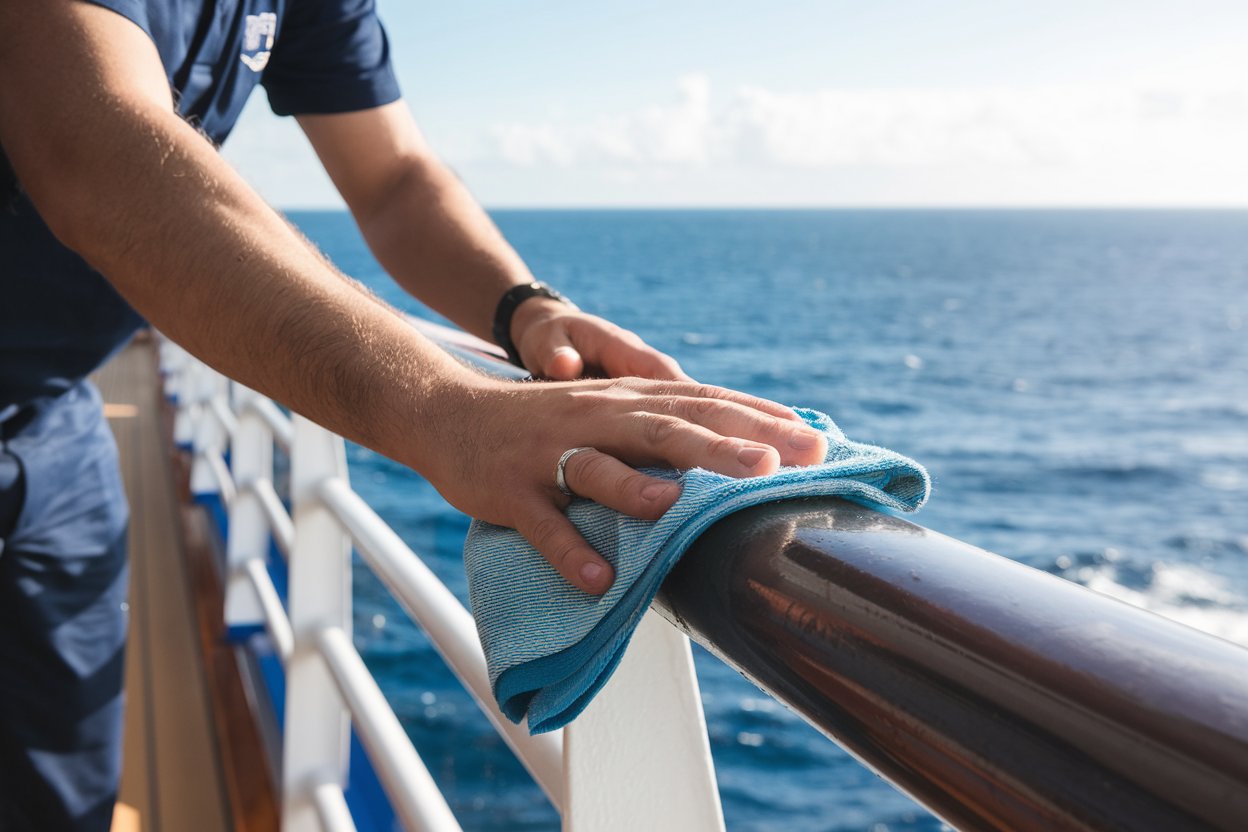
Common Safety Concerns
When you’re preparing for a cruise, it’s normal to have a few questions about safety. Here are some of the most common concerns passengers have, and how cruise lines handle them:
Health and hygiene: With concerns about viruses like norovirus and COVID-19, cruise ships have stepped up cleaning and hygiene protocols. You’ll see frequent cleaning of common areas and plenty of hand sanitiser stations around the ship.
Fire safety: Cruise ships are equipped with advanced fire detection and suppression systems, and the crew is well-trained to respond quickly in case of an emergency.
Bad weather or rough seas: Modern ships are designed to handle rough waters, and captains constantly monitor weather conditions to avoid dangerous areas. If storms pop up, they’ll adjust the route.
Security concerns: From passenger and luggage screenings during boarding to having security staff onboard, cruise ships take security seriously to keep everyone safe.
Falling overboard: Though rare, overboard incidents are a common worry. Ships are built with sturdy railings and even use technology to prevent accidents—most overboard situations result from risky behaviour.

Security and Threats
Cruise ships take security seriously, and they have a range of measures in place to keep everyone safe. Here’s how they handle security and potential threats:
Passenger and Luggage Screening: Just like at the airport, you’ll go through a screening process before boarding. This includes X-ray scans for your bags and metal detectors to check for prohibited items, ensuring no dangerous objects make it onboard.
Onboard Security Teams: Cruise ships have their own trained security staff who are ready to respond to any incidents. They patrol the ship, monitor CCTV cameras, and are trained to deal with a range of situations, from theft to more serious concerns.
Identification and Access Control: When you board the ship, you’ll receive a cruise card that serves as your room key, payment card, and ID. It’s also scanned whenever you leave or return to the ship, ensuring that only authorized passengers are allowed onboard.
Port Security: In addition to ship security, cruise lines work closely with local authorities at each port to ensure safe docking and shore excursions. Security checks are also done when passengers reboard the ship.
Monitoring for External Threats: Cruise ships are equipped with radar and communication systems to monitor for potential external threats, such as other vessels or weather hazards. If needed, the ship’s route can be adjusted to avoid any risks.
Emergency Drills: As part of their commitment to safety, cruise lines require all passengers and crew to participate in a mandatory safety drill at the start of each cruise. This prepares everyone for how to respond in case of emergencies like security threats or evacuations.
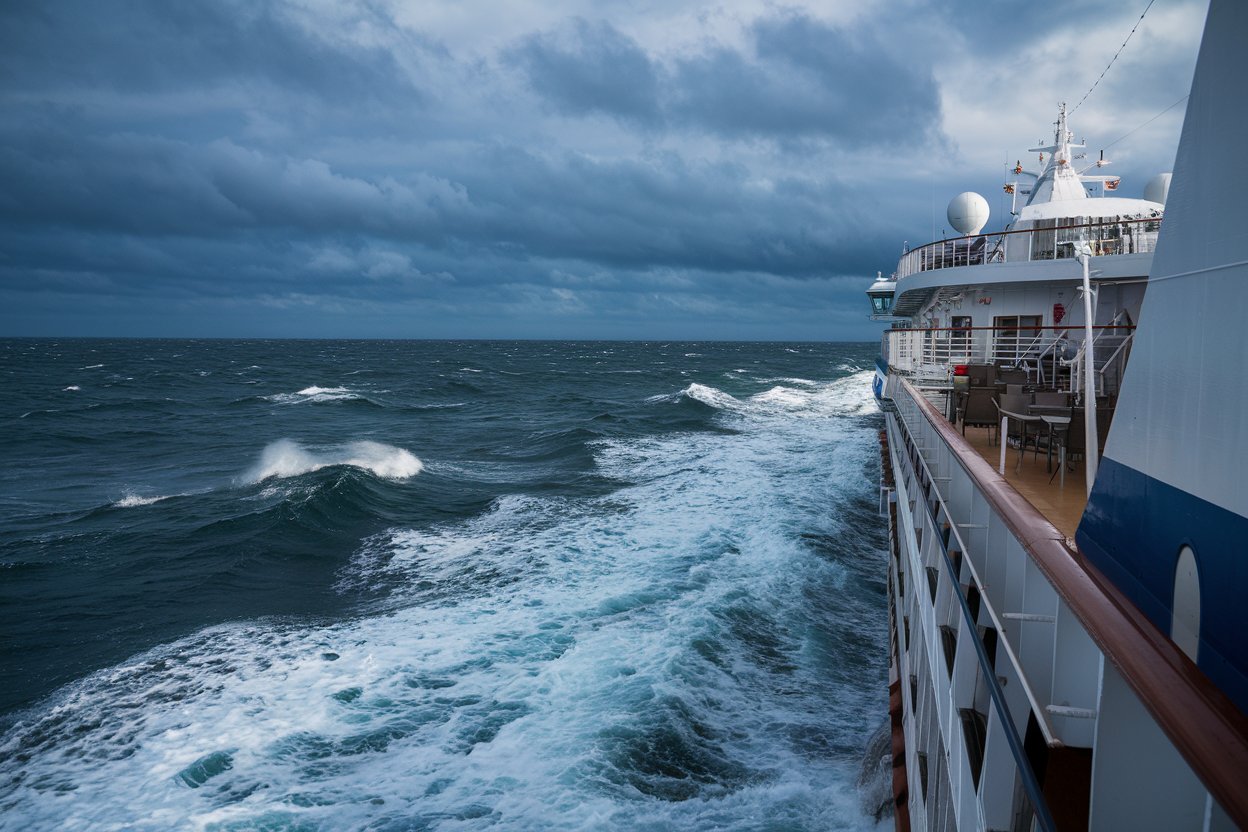
Are Cruise Ships Safe During Storms and Rough Seas?
Yes, cruise ships are generally very safe during storms and rough seas, thanks to their advanced design and technology. Here’s how they handle rough conditions:
Built for Stability: Modern cruise ships are designed to handle rough waters. They’re equipped with stabilizers, which are like underwater fins, that help minimize the rolling and swaying of the ship during rough seas.
Weather Monitoring: Captains and their crews constantly monitor weather forecasts and sea conditions. They have access to real-time satellite data, and if a storm is on the way, they can adjust the ship’s route to avoid the worst of the weather.
Speed and Maneuverability: Cruise ships are surprisingly fast and can outrun many storms or maneuver around them. The crew will always prioritize passenger safety and comfort, taking detours if necessary.
Safety Protocols: In the rare case that a ship encounters severe weather, the crew is trained to manage the situation. Passengers are also informed about any safety precautions, and certain outdoor areas may be closed for safety.
Ship Size Matters: Larger ships tend to handle rough seas better because their size allows them to absorb more of the waves’ energy. You might still feel some movement, but it’s usually nothing to worry about.
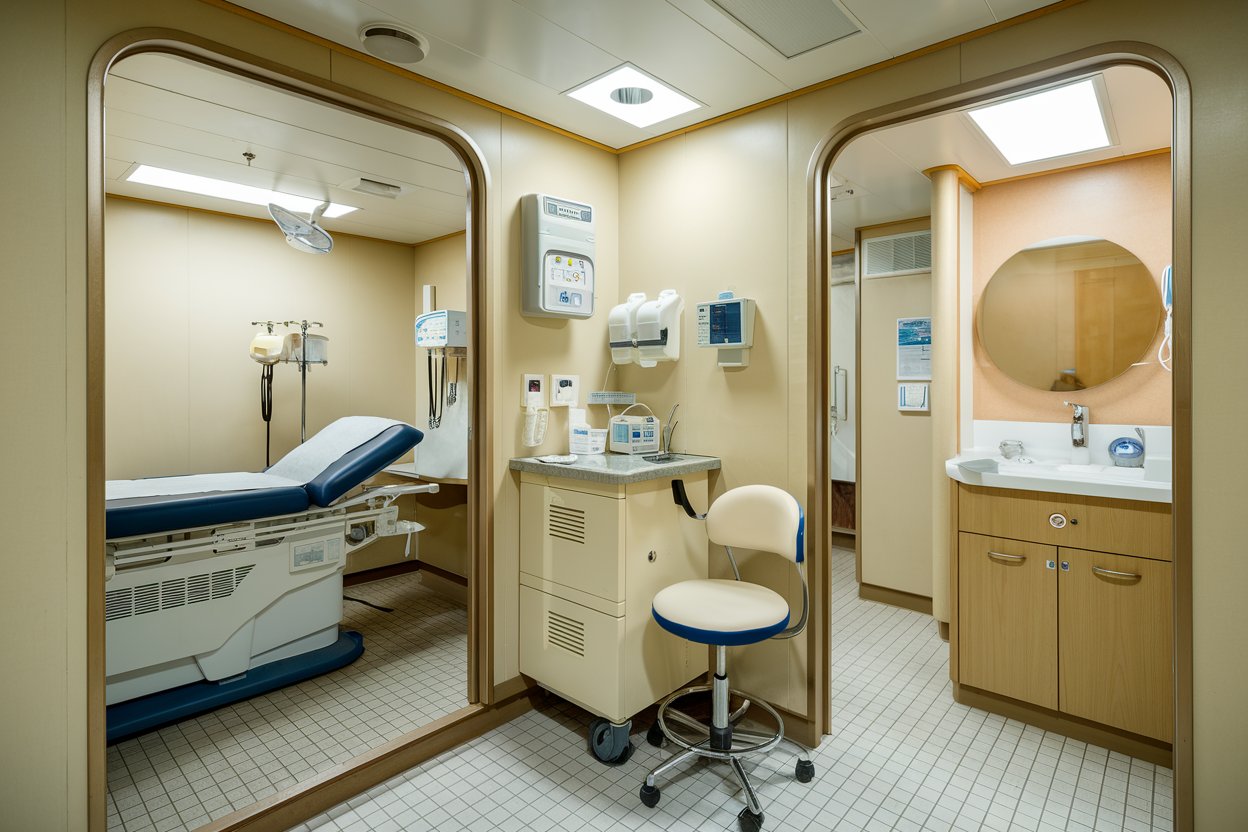
Medical Facilities
Cruise ships are equipped with medical facilities that can handle a wide range of health needs while you’re out at sea. Here’s what you can typically expect:
Medical Center: Most cruise ships have a fully equipped medical center onboard, staffed by licensed doctors and nurses. These centers are set up to handle common illnesses, minor injuries, and some more serious medical situations.
Basic Treatments and Medications: The onboard medical staff can treat a variety of conditions, from seasickness and minor cuts to more significant injuries. They also have medications available for common ailments, like motion sickness, colds, and allergies.
Emergency Care: If there’s a more serious medical emergency, the medical team is trained to stabilize patients and provide urgent care until they can be transferred to a hospital onshore. The ship’s medical center is equipped with necessary tools like defibrillators and ventilators.
Telemedicine: Some ships have access to telemedicine services, allowing the onboard medical team to consult with specialists onshore for more complex cases.
Isolation Areas: Especially after the COVID-19 pandemic, many cruise ships have designated isolation areas in case of contagious illnesses, ensuring that affected passengers are kept separate from the rest of the guests.
Evacuation Procedures: In rare cases where a passenger requires immediate hospital care, the ship can coordinate an emergency evacuation, either via a helicopter or a diversion to the nearest port.

Lifeboats and Emergency Drills
Lifeboats and emergency drills are an essential part of cruise ship safety, and here’s what you should know about them:
Lifeboat Capacity: Cruise ships are required to have enough lifeboats for all passengers and crew, plus extra capacity. The lifeboats are designed to be launched quickly and can hold dozens of people, providing food, water, and supplies in case of an emergency.
Location of Lifeboats: Lifeboats are typically located on the deck, near the sides of the ship, making them easily accessible from the common areas and cabins. You’ll see signs and instructions throughout the ship, showing you where the nearest lifeboats are.
Emergency Drills: Every cruise starts with a mandatory emergency drill, called a muster drill, where passengers are shown how to respond in the event of an emergency. During this drill, you’ll be instructed on how to wear a life jacket, where your designated muster station is, and how to safely proceed there if an evacuation is needed.
Life Jackets: Each cabin is equipped with life jackets, and additional life jackets are available at muster stations. Crew members are trained to assist passengers with putting them on correctly during an emergency.
Lifeboat Launch Systems: The technology used to launch lifeboats is highly reliable. Lifeboats are either lowered into the water using mechanical davits or launched by gravity. These systems are regularly inspected and tested to ensure they work when needed.
Crew Training: The crew undergoes regular training to handle emergencies, including lifeboat deployment. They’re well-prepared to guide passengers in case of any incident and ensure an orderly evacuation, if necessary.

Overboard Incidents
Cruise ships take a number of precautions to prevent overboard incidents, making sure passengers stay safe while enjoying the open sea. Here’s what you need to know:
High Railings: Cruise ships are designed with high railings around all open deck areas, typically around chest height or higher, to prevent accidental falls. These railings are built to be sturdy and are difficult to climb over.
Safety Barriers: In addition to railings, many ships have additional safety barriers, such as glass panels or reinforced netting, especially in areas with a lot of foot traffic or on balconies.
Surveillance Cameras: Cruise ships are equipped with CCTV cameras that monitor public areas, including decks and balconies. These cameras help the crew keep an eye on passengers and can alert them to any unusual activity near the ship’s railings.
Crew Vigilance: The crew is trained to watch for any signs of risky behaviour, like passengers standing too close to the edge or engaging in dangerous activities like climbing railings. They’re trained to intervene when necessary to ensure everyone’s safety.
Passenger Awareness Campaigns: Most cruise lines run safety campaigns that remind passengers to follow basic safety rules, like not leaning over railings or engaging in horseplay. These messages are delivered through signage and announcements.
Motion Sensors and Technology: Some newer cruise ships are equipped with advanced man-overboard detection systems that use motion sensors and cameras to immediately alert the crew if someone falls overboard. This allows for a rapid response in case of an emergency.
Restricted Access to Dangerous Areas: Certain parts of the ship, like areas with heavy machinery or risky heights, are off-limits to passengers. These restricted areas are clearly marked and secured to prevent unauthorized access.

Tips for keeping yourself safe
Use the Safe in Your Cabin: Most cruise cabins come with a small safe. Store valuables like passports, extra cash, jewellery, and electronics there when you’re not using them.
Keep an Eye on Your Belongings: When you’re on deck or at a pool, don’t leave your personal items, like bags or phones, unattended. Bring a small beach bag or lockable backpack to keep things secure.
Avoid Flashing Expensive Items: While onboard or during shore excursions, try not to wear flashy jewellery or carry large amounts of cash. It’s safer to be discreet with valuables.
Stay Aware in Crowded Areas: The most crowded areas, like the buffet or during boarding and disembarking, are prime spots for pickpockets. Keep your bag zipped and close to you in busy areas.
Use Credit or Cruise Card Instead of Cash: Most cruise lines work on a cashless system where you charge everything to your room with a cruise card. This reduces the need to carry large amounts of cash around the ship.
Lock Your Cabin Door: Always lock your cabin door when you leave, and even when you’re inside. Cruise ships are generally very safe, but it’s a good habit to have.
Secure Your Balcony Door: If your cabin has a balcony, make sure the door is securely locked, especially when you’re away or asleep.
Be Cautious During Shore Excursions: On shore, stick to well-known areas and avoid showing valuables. Consider carrying a money belt or hidden pouch to keep important documents safe.
Stay in Well-Lit, Populated Areas: Whether on the ship or during excursions, stick to public, well-lit areas, especially at night.
Keep Important Documents with You: Always carry a copy of your passport, cruise card, and any important travel documents when leaving the ship, but leave the originals safely locked away in your cabin.
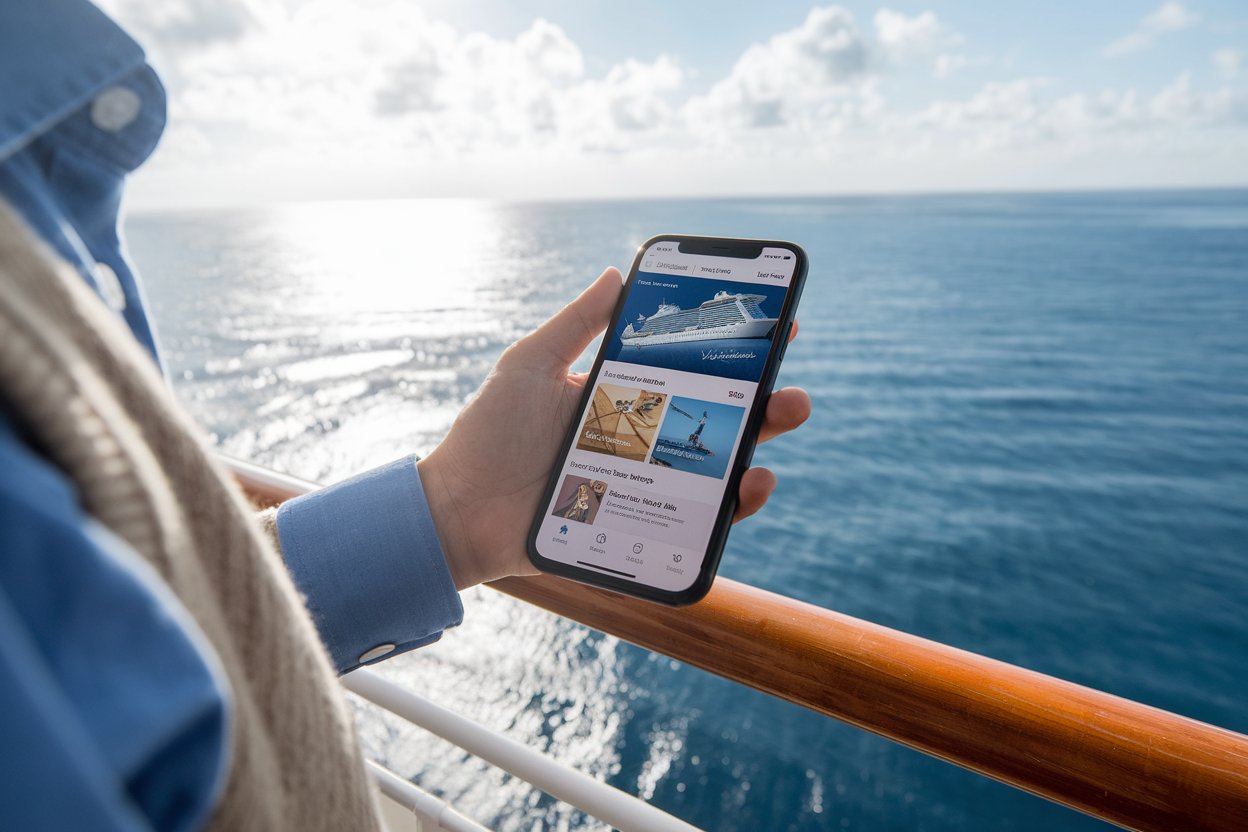
Latest Tech in Cruise Safety
Here are some of the latest technological advancements in cruise ship safety:
Real-Time Passenger Tracking: RFID bracelets and apps allow cruise lines to monitor the location of every passenger and crew member in real-time, improving response times in emergencies.
Advanced Navigation and Weather Systems: State-of-the-art radar and satellite systems help ships avoid extreme weather and dangerous seas.
Fire Suppression Systems: Modern ships are equipped with advanced fire detection and suppression systems, like water mist and gas systems, to quickly address onboard fires.
Eco-Friendly Safety Measures: New ships implement advanced waste management and water treatment systems to comply with environmental regulations while keeping passengers safe from contaminants.
Enhanced Cybersecurity: With increasing digital connectivity onboard, cruise lines are investing in stronger cybersecurity protocols to protect against data breaches and network security threats.
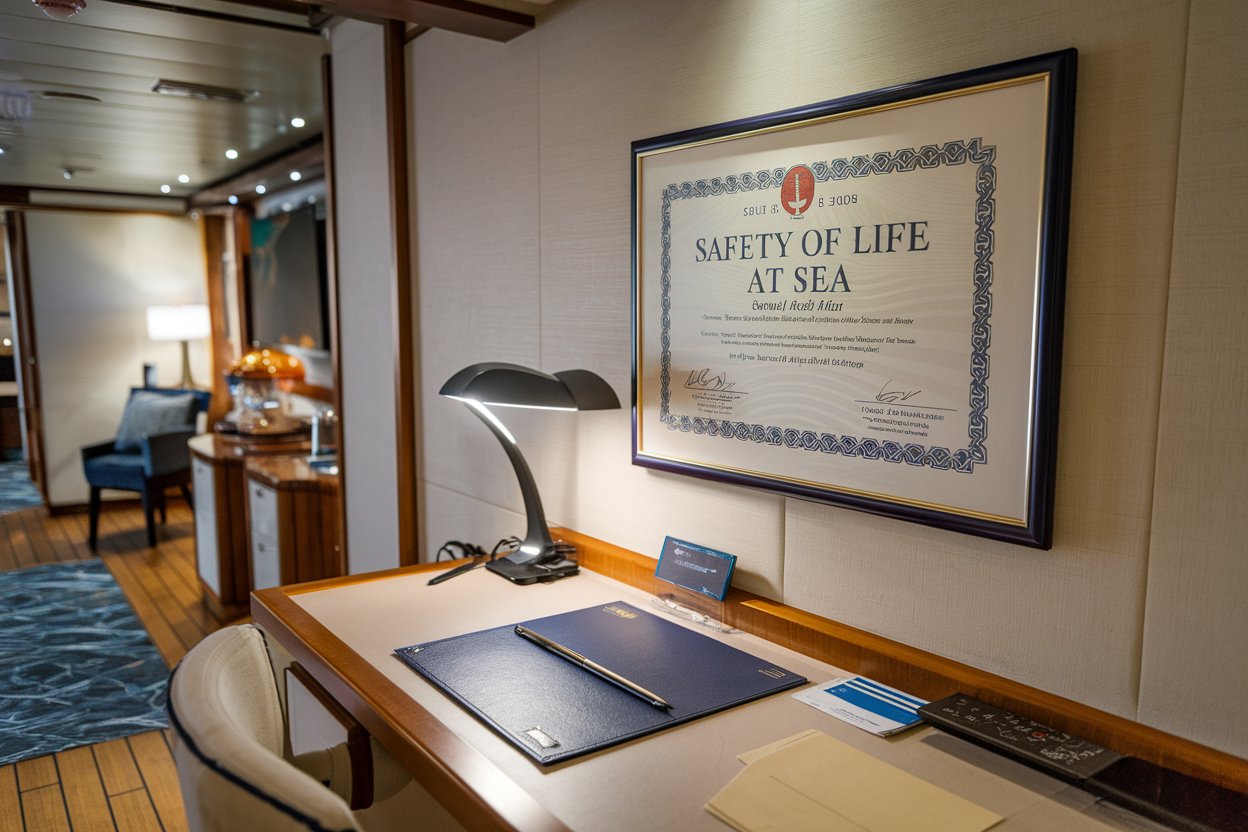
Safety certifications
Cruise ships have to meet several safety certifications to keep things running smoothly and safely. These standards cover everything from emergency equipment to environmental practices.
Whether it’s making sure the crew is trained, preventing pollution, or keeping food safe, these certifications make a big difference in your onboard experience.
Here’s a breakdown of the key safety certifications most cruise ships follow:
SOLAS (Safety of Life at Sea): A key international maritime treaty focused on the safety of ships, it sets minimum safety standards for construction, equipment, and operation, including life-saving gear, fire protection, and emergency protocols.
ISM Code (International Safety Management Code): Ensures the safe operation of ships and the prevention of pollution, requiring cruise lines to implement safety management systems covering emergencies, maintenance, and staff training.
MARPOL (International Convention for the Prevention of Pollution from Ships): Regulates the prevention of marine pollution by ships due to operational or accidental causes, including oil, chemicals, and waste discharge.
STCW (Standards of Training, Certification, and Watchkeeping): Requires that all crew members are properly trained and certified, with competencies in safety procedures, navigation, and emergency preparedness to ensure safe vessel operation.
CLIA (Cruise Lines International Association): Member cruise lines adhere to strict safety guidelines, including comprehensive emergency drills, security measures, and crew training, ensuring a high standard of safety across their fleets.
ISO 14001: This environmental management certification focuses on reducing environmental impact, ensuring ships implement best practices for waste management, pollution control, and sustainable operations.
USPH (U.S. Public Health Service): Covers stringent health and sanitation inspections for cruise ships visiting U.S. ports, including food safety, water quality, and cleanliness of facilities to protect passengers from potential outbreaks.
Get honest cruise advice that puts your interests first.
Jo and the About2Cruise team provide expert guidance to help you choose cruises based on reality, not marketing promises. Find out more about us.
